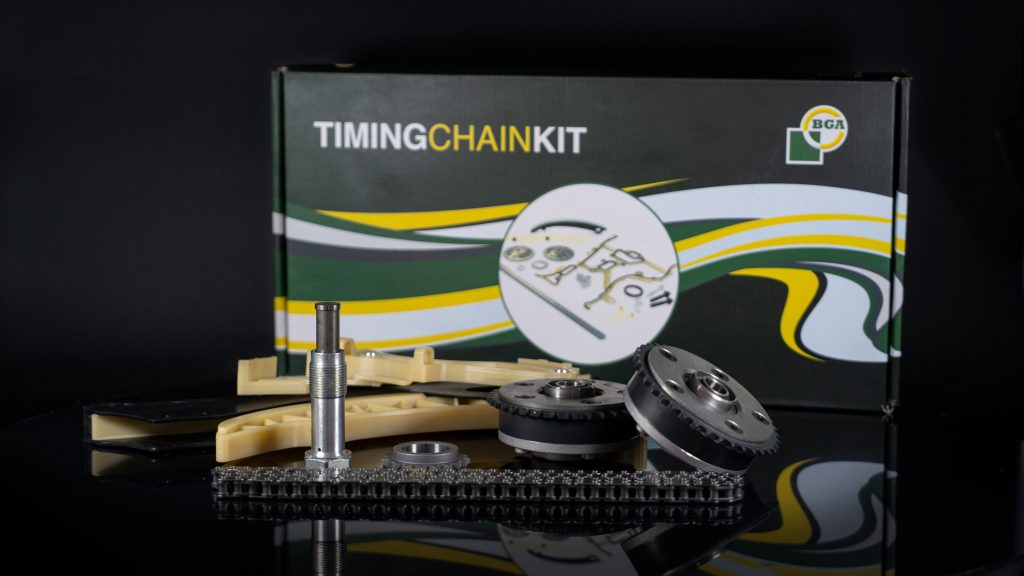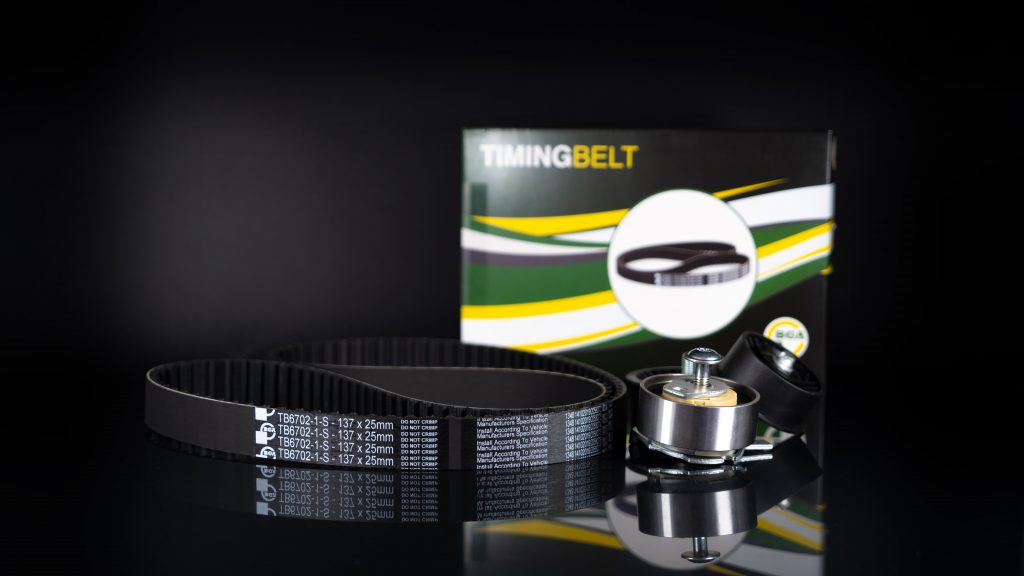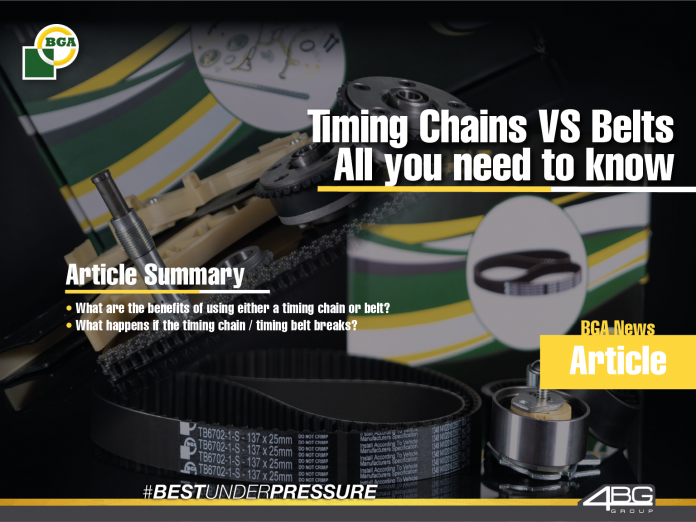A question asked by many drivers… and the answer is not as straightforward because both components accomplish the same function: they synchronize the crankshaft and the valvetrain for the valves to open and close at the correct time in synchronization with the pistons.
Timing belts and chains are an essential part of the internal combustion engine. Even though they are a pretty simple part, their importance in ensuring that the engine is able to function at all is very important.
The main difference between a timing belt and a timing chain is their material and shape. At the beginning of the automotive era, predominantly timing chains were used to synchronise the bottom and the top half of an engine. It was simpler that way as reinforced rubber as we know it now simply did not exist back then. By the 1960s, due to many chemical innovation’s engineers have started to use reinforced rubber timing belts.
Rubber belts were less expensive to produce and quieter than a metal chain, they did not need any lubrication and lasted a fair amount of time.
Belt-driven engines are cheaper to manufacture and might require more maintenance than a chain-driven engines, but many consumers don’t realize that; they just look at the vehicle’s price tag. Another reason a manufacturer might use a timing belt system is to make the cooling system simpler.
Even though timing belts are less noisy than a timing chain. Both systems are in constant development and thus each have their own pros and cons. Some vehicle manufacturers do not stick to one type (rubber or chain) and keep alternating between them due to different factors.
What are the benefits of using a timing chain instead of a belt?
Old timing chains were highly durable which usually lasted the engines lifetime. However, like any other mechanical component they occasionally failed.
The durability of a modern timing chain is now uncertain; it varies from manufacturer to manufacturer and from engine to engine. Most automakers don’t specify a replacement interval. Many modern engines still have highly durable timing chains, but there are some chain-driven engines that, due to a faulty design or poor construction, need to have the timing chain and any other related components replaced before they reach 74,500 miles (generally between 36,000 to 50,000 miles).
Some automakers and parts manufacturers are aware of these problems and thus they have manufactured timing kits that are harder and more reliable than the factory-fitted parts.
Timing chains can handle a lot of power; that’s why they are preferred by most pickup and truck manufacturers. Timing chains are also more often resistant to temperature changes in comparison to a rubber-based timing belt.
The superior advantage timing chains have over timing belts is that they usually don’t fail catastrophically; they stretch first, making a loud rattling noise, giving the vehicle’s owner a warning and enough time to attend to the problem before it fails completely. On rare occasions, a timing chain will suddenly break or skip enough sprocket tooth’s to damage the engine.
Timing chains are overall more reliable and durable than timing belts; however, it’s always good to have them inspected between 74,500 – 93,000 miles and to change the oil regularly to ensure that everything is running smoothly and thus prevent premature failure.

What are the benefits of using a timing belt instead of a chain?
Timing belts are cheaper than timing chains. Belt-driven timing systems are simpler than their chain-driven counterparts because they are not lubricated, and they don’t need guide rails and many more components. Timing belts are also quieter than timing chains – reducing the noise and vibrations coming from the engine.
A timing belt is also lighter than a timing chain which in turn makes the engine more responsive. Another positive aspect of a timing belt is that they are more flexible than timing chains, allowing manufacturers to save space because they can route them around tight spaces and turns.
Belt-driven engines use the timing belt to propel the water pump. Most chain-driven engines are designed so that the water pump is not driven by the timing chain.
Timing belts also rotate more smoothly than chains, reducing parasitic loss, increasing the engine’s power output, and saving fuel. Because of their characteristics, timing belts are ideal for small displacement engines.
However, timing-belts have some cons; they need to be replaced every 37,000 to 62,000 miles and may break without any warning. They are much easier to replace than a timing chain due to its location and the way it is routed within the engine. When replacing a timing belt, it is often replaced with the water pump which saves on the labour cost. On a chain-driven engine the water pump is replaced by a separate procedure which will incur an extra cost.
Timing belts usually degrade over time and start drying and cracking as they are exposed to the external elements. However, if the timing belt is replaced at the correct internal as indicated by the manufacturer it is unlikely for a timing belt to fail prematurely.

What happens if the timing belt Breaks?
When a timing belt breaks, the camshaft controlling the valves and the crankshaft controlling the pistons will lose power and synchronisation. This will likely cause damage in an interference designed engine. As the timing belt snaps, the pistons will continue to go up and down until they are completely stopped. The camshafts will stop turning immediately as it loses power from the crankshaft. If a piston hits a valve as its going up, the valve will bend causing internal damage which is likely to lead to other cylinder head components damage.
Some engines will have all their valves bent if the timing belt breaks – others engines may be less prone to suffer from valve damage. There can also be other side effects when the timing belt breaks, like damage to the timing belt’s pulleys, tensor, and water pump.
In summary, best-case scenario – the engine will need a new timing belt kit. Worst-case scenario – the cylinder head will need to be rebuilt, the head gasket, damaged pistons, and eventually connecting rods will have to be replaced, along with the timing belt kit and other components; in other words, the engine will suffer a catastrophic failure and likely be uneconomical to repair.
About BGA (BG Automotive):
BGA is an Automotive Aftermarket parts supplier, celebrating over 90 years of OE manufacturing heritage as the aftermarket division of the largest privately owned OE supplier, 4BG Group, established in 1929.
BGA focuses on providing one of the largest ranges of high quality, competitively priced parts in the aftermarket containing Auxiliary Drive, Camtrain, Cooling, Gaskets, Lubrication, Power Steering, Steering & Suspension, Timing Belt Kits, Timing Chain Kits and Transmission.


